I decided to spy on a couple of savvy companies that are fairly smart about lead generation to find out what tactics they were using. Here are some very clever strategies I discovered that you may want to copy for yourself.
Business #1 – HubSpot
HubSpot is a very successful company that offers a highly profitable marketing, sales, and service software platform. The software is priced fairly high and HubSpot’s clients are worth quite a bit. Every lead is potentially extremely valuable and because the software is not inexpensive, HubSpot must do some work to win the trust of its website visitors. Here are a couple ways they capture visitor information by educating and answering questions.
We will look at 2 tactics from HubSpot – one involving a free downloadable guide and another using an automated chatbot.
Tactic 1 – Free Downloadable eBook (ebook)
I discovered HubSpot’s tactics by doing a search on lead generation and clicking a link that took me to this web page – Lead Generation: A Beginner’s Guide to Generating Business Leads the Inbound Way (viewed August 15, 2019).
The web page consists of a very helpful guide of over 5,000 words teaching the basics of lead generation. The guide goes beyond simplistic, common sense information and offers a good foundation for anyone who is new to lead gen (I recommend reading it).
If visitors want more information on lead generation, HubSpot also offers a free downloadable ebook called “An Introduction to Lead Generation” which was promoted via a graphic at both the beginning and end of the article and from what looks like a chat window that persists through the entire page scroll. So no matter where you are on the page, visitors see an offer to download the free ebook. Even though each of the links takes visitors to the same page where you could fill out a form and download the guide, they were all separately tracked so HubSpot can learn which of the three promotions are producing the greatest number of clicks and filled out leads.
To receive the free ebook, visitors had to first provide their first and last name, email, phone number, website URL, company name, how many employees work at their company, and answering Yes or No if their company sells web design, online marketing, SEO/SEM, or advertising agency services.
This is quite a bit more information than many sites require in their lead generation forms. What do you think HubSpot is doing? Is it smart to require this much information and risk visitors leaving before filling out the form?
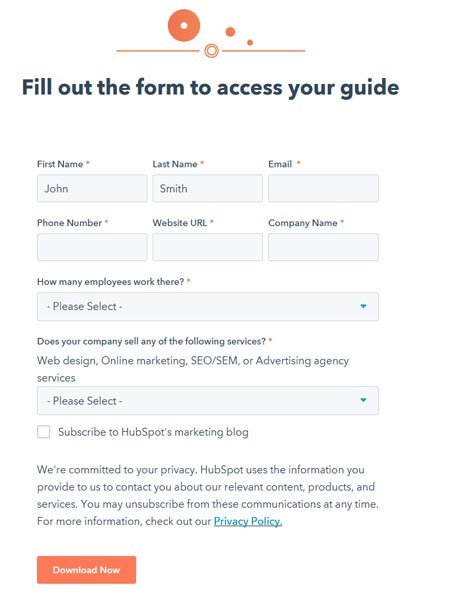
One important aspect of lead generation is qualifying your leads. Not everyone who visits your website is going to become your customer. HubSpot knows that not everyone looking for free lead generation information is going to be the right fit for their expensive software. However, HubSpot isn’t looking for just a high number of leads. They want the right leads – people who will turn into customers and generate revenue for their company.
Think about how all these fields prequalify anyone who fills them out. HubSpot knows instantly a lot about anyone who answers these questions – who they are, who they work for, the size of the company, and if the company offers related services to HubSpot’s product. HubSpot can then segment the people who fill out that form into various groups and market to them based on which of their services might best match their needs.
The form itself does a lot of marketing work for them right up front. They don’t need to email or call these leads to learn more about them. The information is provided by the user right away and HubSpot can tailor their offers accordingly. They also can pursue joint ventures with companies that sell services that are complimentary to their own.
Why this tactic works:
- The 5,300 word short guide on the web page was very helpful and not common sense, simplistic lead generation advice. It was good enough to make a reader interested in downloading the longer guide.
- The ebook is marketed as “An Introduction to Lead Generation” and explained as “A starter’s guide to converting website visitors into leads for your business.” The content of the ebook is a natural fit for readers of the web page and offers them a logical next step for anyone wanting to learn even more about lead generation.
- The information in the free web page is presented in a non-threatening way that sounds more educational than sales-focused. The only time you might feel like you are being sold something is when you are asked for fairly detailed information when filling out the required form to get the free ebook. At that point, the user has to make a decision whether the information HubSpot is offering is worth the information they are requiring from them.
How you can use this tactic:
- Create a downloadable guide or ebook that contains content related to something you sell and would be of interest to your target audience. Promote your services strategically throughout the guide.
- Take a chapter from the guide, or create a shorter summary, and use it as a web page or blog post. Call it a short guide or tutorial. Actively promote the longer, downloadable version from several places on your short guide web page to ensure your visitors see the offer (see how HubSpot does it for ideas).
- Build a form to capture information from anyone who wants to download the guide. The information can be as simple as requiring a first name and email address or it might require more detailed information you want to collect from your visitors in order to better segment and qualify them.
- Steer visitors from related sections of your website, or get traffic directly from search engines, to your blog post or web page short guide. Start collecting leads.
- Test calls to action for your downloadable guide to increase the number of visitors that turn into leads.
This lead generation tactic obviously takes quite a bit of work but the content you write for your guide can be reused wherever you want. Each chapter, or parts of a chapter, can be turned into their own web pages or blog posts that function as ways to funnel visitors to your downloadable book lead magnet.
Tactic #2 – Automated Chatbot
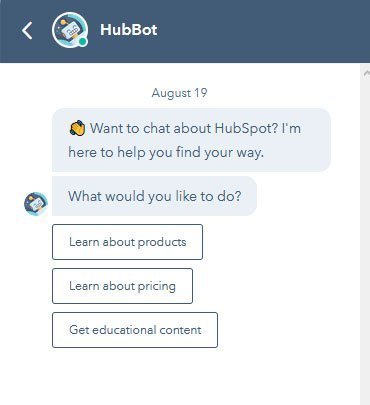
Chatbots have become a very popular automated tool to relieve the load on support personnel and automatically answer visitor questions at any time of the day. HubSpot uses a chatbot in a smart way to direct visitors toward their lead generation methods on their site.
No matter where you enter HubSpot’s site, an automated chatbot appears in the lower right corner. When you click it, it asks what you want to do or what you are interested in. It then offers several choices for you to click on. These choices change depending on where you enter the website.
For instance, on the home page, the choices were:
- Learn about products
- Learn about pricing
- Get educational content
Clicking “Learn about products” resulted in the question “What’s your biggest business challenge right now?” and the following options for me to click:
- Generate more leads
- Close more deals
- Manage my contacts
- Provide better service
Clicking “Generate more leads” resulted in more decisions:
- Get started for free
- Chat with someone
- Read more
Clicking “Get started for free” took me to the free signup for HubSpot’s CRM solution which requires first and last name and email address or in other words – a free trial lead generation magnet.
Why this tactic works:
What the chatbot did was basically provide an interactive tool to steer me toward the closest services I was interested in. That doesn’t sound that much more interesting than standard, link based website navigation but think of the possibilities:
- You could use the automated questions to segment leads. You could separate customers who are ready to buy from customers who aren’t, customer who know what you offer and those who don’t, customers from large companies from customers with small companies, business owners vs. non-business owners and so on.
- The chatbot could be used to steer customers toward several types of lead generation tools you already have set up on your site. Use Tactic 1 above and steer customers toward a free information download such as an ebook. Or steer them toward a survey that captures their information. Or steer them toward a free trial of one of your services. Or use a co-registration form via partnership with another company and sell the lead.
How you can use this tactic:
Online automated chatbot software is something you can plug into your existing site. I haven’t tried any of these yet, but here are a few companies that offer them:
- HubSpot – if you want to use the same technology HubSpot is using on their site, they do have a chatbot builder as a part of the customer relationship management suite. You can get started with HubSpot for free but it is limited and plans get expensive quickly and is priced based on the features you want and the number of contacts you want managed.
- ChatBot – ChatBot is owned by LiveChat, a popular chat technology. Bots can be created with no coding skills necessary
- ManyChat – ManyChat integrates into Facebook Messenger and lets you create automated chatbots from templates. You can program the bot to answer common questions and send traffic to your lead pages to convert to sales.
Business #2 – Mirasee
Mirasee is an online course creation training company that incorporates lead generation throughout their site. We’ll look at a couple of clever tactics they employ to capture user information.
Tactic 1 – Book Summary Video
If you have any kind of offline promotion, you may wonder how you can go about capturing leads. Here’s a clever way used by Mirasee.
I purchased the book “Teach and Grow Rich” by Mirasee founder Danny Iny. On the first page of the book, readers will see the following image:
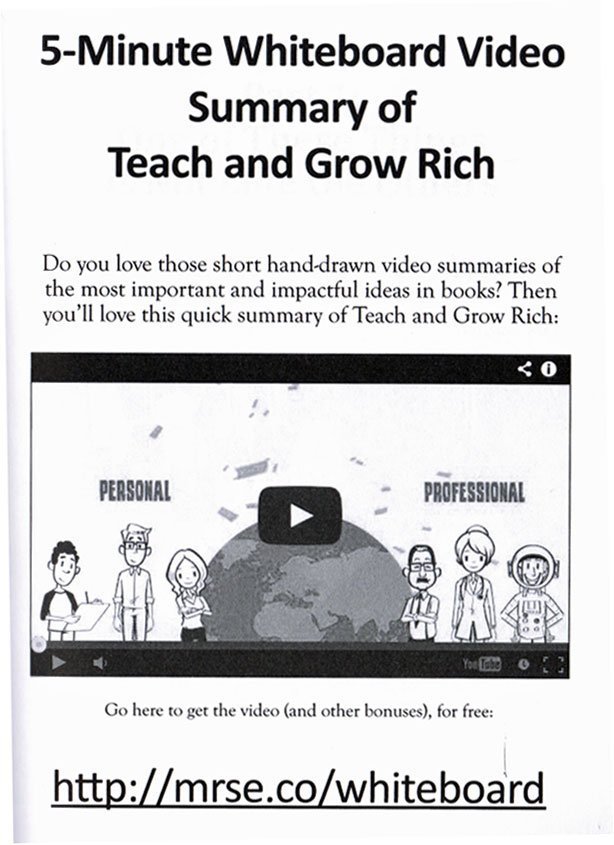
Who wouldn’t want a quick and entertaining overview of the essential ideas in a book before you invest the time to read the whole thing? I certainly did and was curious how this tactic was going to be used. So I typed in the above URL.
I was taken to a simple landing page where, in order to view the summary video, you had to input your first name and email address. Although this was slightly annoying, I think the company figured that if someone took enough time to put down the book and type in a link, they would be willing to jump through one more hoop to see the video by giving their personal information.
So I input a fake email address and was taken to the video page where I watched an entertaining video that summarized the book and encourages the viewer to take action and create an online course with their existing knowledge.
However, Mirasee wasn’t done. They had already captured an email address but the video page included two more ways to take visitors even deeper toward their revenue generating offers.The video page included two links:
- Show Me My Superpower – a link to a simple online quiz with multiple choice questions about a visitor’s interest in creating and selling an online course. At the end, the quiz would tell you what superpower you had along with offers to join Mirasee’s online course building programs.
- Join Facebook Group – the link takes visitors to a Facebook group page that you can join and get exposed to Mirasee’s community and social media marketing strategy.
Why this tactic works:
Mirasee knows that some people will purchase the book and may not engage with their online services. Since their core business is not book selling, the book’s purpose is to establish the credibility of the author and work as a lead generation tool to sell their expensive courses.
In comparison to selling an online training course, most books produce very little money. Therefore, integrating ways to move customers from offline engagement into an online sales funnel is extremely important. Offering a video summary of the book was a clever way to give book readers something they were probably interested in and capturing their name and email before giving it.
How you can use this tactic:
- If you are thinking of writing a book, you can copy this tactic exactly. You can create a short script that summarizes the book and then hire a whiteboard animator on an outsourcing site like Fiverr.
- If you don’t want to write a book but are using other forms of offline advertising, you can easily advertise a link to an entertaining and informative video and follow the same process.
Tactic #2 – 2 Lead Gen offers off 1 Blog Post (and 1 missed opportunity)
Most of us are using blogging as a primary way to reach an audience through search engine traffic. But are we really maximizing our lead generation on our blog pages?
Mirasee has two different lead generation offers on its blog pages that could have easily been three.
For instance, I clicked on their blog and then went to this page – “How to Grow Your Blog: A Proven Roadmap to 10,000 Readers“
Lead Gen Offer #1
At the very top of the page where you would normally see a featured image or banner ad, is a large image promotion for a Free Course Builder’s Bootcamp.
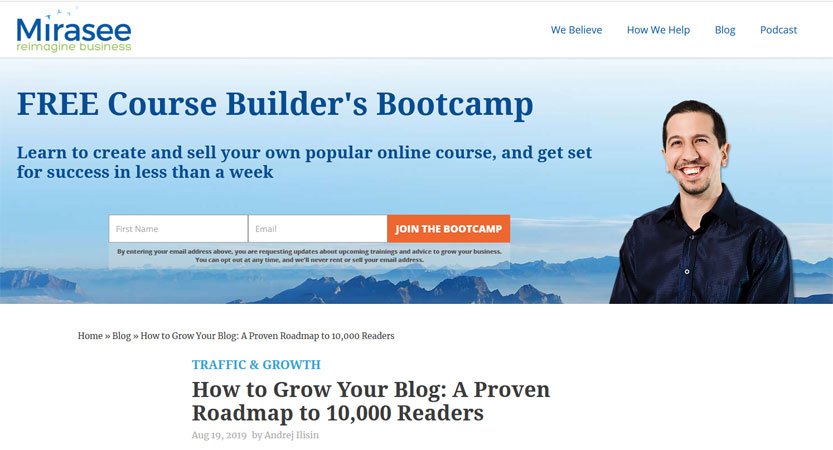
Notice how the actual blog content is pushed down quite a bit from the top of the page. Clearly, getting visitors into the sales funnel to later upsell to more expensive courses is the top priority for this company. The highest revenue generating lead magnet is getting the priority it deserves by occupying the most important spot on the page. Th free blog content is secondary.
Lead Gen Offer #2
Once a visitor is done reading the blog page, another offer appears at the end of the article. Obviously a reader is ready to do something else once they are done reading. Their mind has already been engaged by the blog content and now is a good time to help them take a next step by offering them more free content with a lead magnet.
Mirasee has opted for a free downloadable guide that is somewhat related to the topic of the blog content – Designing Your Audience Business.
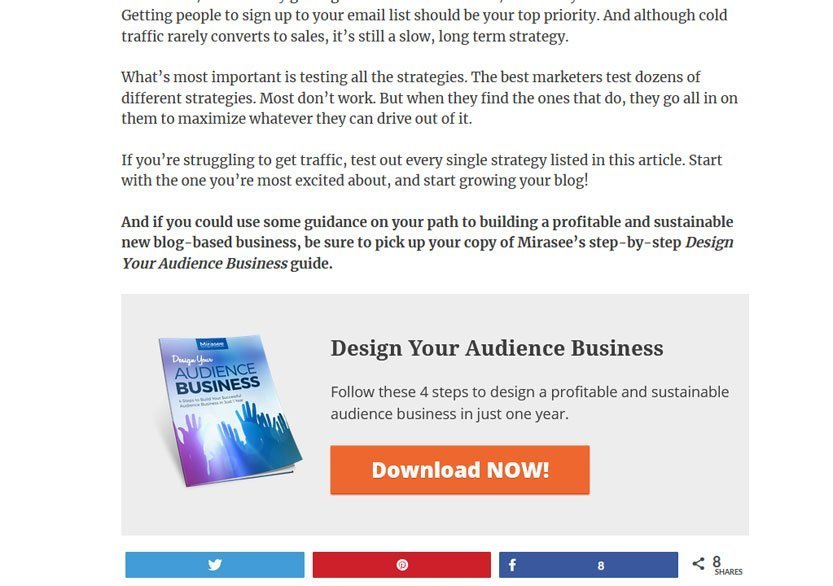
When visitors click the “Download Now” button, a lead gen popup appears asking for a first name and email address before the guide can be downloaded.
Again, it is important to note the guide isn’t just given away for nothing. Users must provide their information and become a potential lead before getting it.
Too often site owners think they need to give everything away for free. Instead, always be thinking of ways to create deeper relationships with your visitors and capture their information to communicate and sell to them later.
A Missed Opportunity
When I was first writing this, I thought Mirasee had wisely integrated a third lead gen offer into the actual content of the blog post. Here is the image I noticed when first scanning the page:
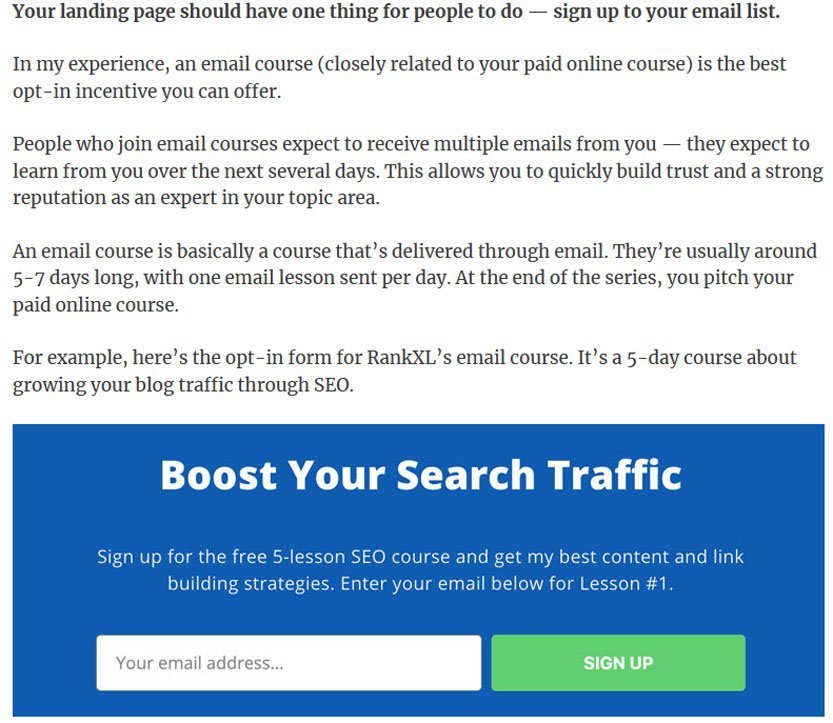
I though Mirasee was offering a free SEO course via email in this blog post. It would have been a perfect fit – a blog post about building your readership and then offering a more in-depth SEO course via email as a lead magnet.
However, this blog post was actually a guest post and the author was using this as an example from another company called RankXL. Now maybe there is some connection between the guest author and RankXL, but this could have been an opportunity for Mirasee to promote their own email course about building traffic.
If Mirasee had done this, they would have had 3 lead gen offers on this single blog page – one at the top of the page, one integrated in the content, and one at the end of the web page. All of them would have been unique offers and all of them could have been lead magnets.
How you can use these tactics:
- Look at your current most popular blog pages. How many lead generation tactics are you integrating?
- Try coming up with 3 different lead magnets. Offer your most potentially profitable magnet prominently at the top of the page under the site logo and navigation but before the top of the post. Integrate one offer within the blog post itself (ideally this one would be tightly related to the blog content), and offer one more at the end of the post that might be a natural next step for the reader to take.
Conclusion
I hope you came away with several ideas for lead generation after reading this article. Lead generation is a fantastic way to build your own potential customer list or sell the leads to other companies for a nice revenue stream.
You can learn lead generation by reading a bunch of theory or you can study how the very best marketers are doing it online and then adapting the tactics to your own website. I prefer to learn from companies that are actually doing it successfully – especially tactics that bridge the gap between free content such as blog posts and paid services.

